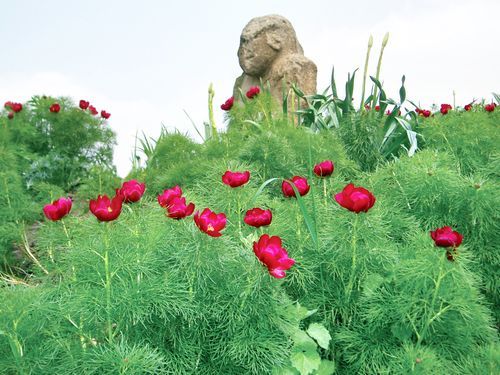“Ukrainian steppes” between Donetsk and Makiivka
Botanic garden as green treasury of the region
Donetsk-based Botanic Garden is a real paradise of living nature, with plants from many countries growing on the area of 203 hectares. But the most important thing is that here, on Donetsk-Makiivka border one can catch the home smell of Ukrainian steppes, the nomadic identity hidden in the cities under numerous buildings and cars.
The garden is an experimental-research nature lab, created namely with an aim to resolve some ecological issues of the region and also protect the gene pool of Ukraine’s south-east. The garden was founded in 1964. Everything started with a living apartment, used as premises for collecting plants. A total of 260 species were collected over the initial five years, many of the species were given by nature-lovers. Its further development is integrally connected with the name of scientist Yevhen Kondratiuk who laid the foundation for the collection fund of living plants and determined the main directions of further studies. In 1983 the garden acquired the status of monument of landscape art. Somewhat later it was awarded with a medal for environment protection.
One cannot but notice the big glass dome and well-tended territory, where there are rare many-colored bushes and tall trees, and the entrance is adorned with a big forged rose. This fairy-tale-like beginning charges one with romantic mood.
The territory is divided into the South and North parts. The arboretum is located in the first one. Namely here there is the most unique exposition “Steppes of Ukraine,” which was granted the status of national heritage in 2001. It represents almost the entire natural wealth of the region. Of course, it is in summer that the manmade steppe shows the whole palette of colors.
In the North part there are greenhouses, as well as an administrative-laboratory complex and the main collections of plants that grow in open soil. In May one can enjoy here the dizzy aromas of tens of lilac varieties, and in summer this “town of million roses” will present for your attention the unheard-of number of these beautiful flowers. And if you decide to come to this place in autumn, you will be able to feast your eyes on flowering chrysanthemums. The forged artwork alley “Inspiration” looks especially nice in the snowy winter time. And finally, for those who like exotic plants there are rare expositions of tropical and subtropical plants located in five greenhouses. Every greenhouse unites on a small area plants from different corners of Earth, representing various kinds of flora and types of vegetation.
As you enter the first greenhouse, you find yourself in the world of palms, cactuses, flowers, and herbs of a variety of colors and shapes. For example, there is a huge Phoenix canariensis. A botanic garden employee told us that in its home region the tree does not usually get so tall. Apparently, the generous Ukrainian black soil is favorable for the plant. Actually, the glass dome was installed specifically for this giant.
Here you will also hear about many other interesting plants, such as Epipremnum aureum, which actively absorbs nicotine, or Ceiba pentandra called “tree of peace” by American Indians, who believed that its roots are connected with the afterlife world and its branches see one to heaven. In the second greenhouse there is a tree whose leaves resemble a sausage, Kigelia pinnata, and there is also a unique cactus Echinocactus grusonii. One can also see mandarins, oranges, papaya, melons, Cyphomandra betacea, pomegranates, and many other fruit of earth. In the next premises you will see the Yucca tree, which according to the legend saved a ship from wreck, holding it with the help of its strong branches, since that time it became known that this tree’s wood is as strong as steel ropes. Especially precious is the rare Dracaena draco, a red-listed species. Its top ends in side branches, which carry rosettes of numerous leaves – the “head of the dragon.” “Dragon blood,” bright-red tar, because of which the plant was called dragon tree, will stream from the trunk if the tree is cut.
And this is only a small part of interesting specimen, taking into account the fact that the collection of the Botanic Garden counts for over 70 species of plants which are protected by international environment protection organizations, as well as 90 special protected on regional level. Besides, about 100 species of red-listed plants are growing on its territory. The excursions to the greenhouse complex are held from Monday till Thursday, and you can get to know the spirit of Ukrainian steppe and walk along the picturesque lanes of the park from Tuesday till Friday. You can simply walk in the garden on any day, except for Monday.
COMMENTARY
Olena POPLAVSKA, biologist, head of youth environmental initiative, Donetsk:
“The Donetsk-based Botanic Garden, although not so large, is yet versatile in terms of the variety of species adapted to our climate. For example, there is the wonderful Crimean magnolia, which creates a beautiful bouquet together with the steppe herbs and plants. In spring you can visit the garden every week to see how the integumentary carpet of primroses of a great variety changes. There is also a rose garden, an arboretum, and an apple garden. There is a good greenhouse. The garden exists namely on people’s enthusiasm. It needs colossal support. For example, in the 1990s the premises were not heated, and the plants survived thanks to the careful and tender attitude of the employees. Although today the problems may not be so grave, they are still numerous.”
Выпуск газеты №:
№16, (2013)Section
Time Out





